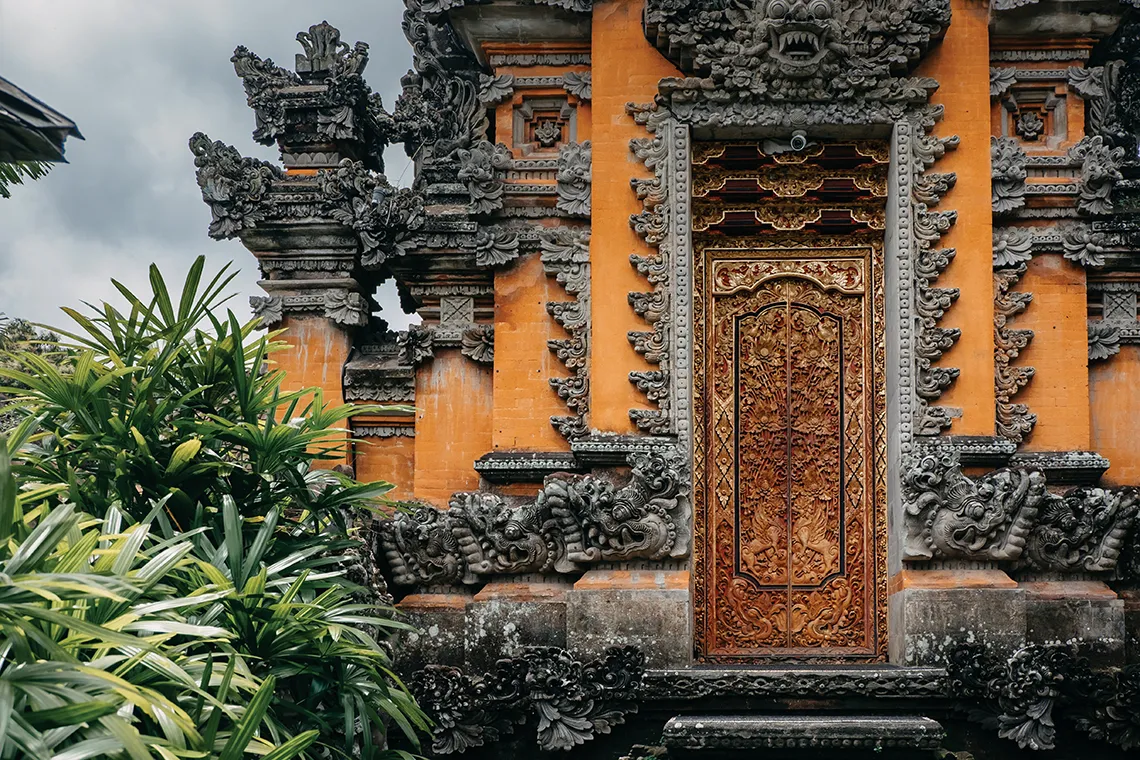Saraswati Lotus Temple
- shan157
- May 16
- 3 min read
Updated: Jul 29
Ubud’s Iconic Water Temple
Pura Taman Saraswati, also known as the Ubud Water Palace or Pura Taman Kemuda Saraswati, is a striking water temple tucked just off Jalan Raya in central Ubud. Built in the mid 20th century, it offers a peaceful escape from the surrounding shops and cafés. Commissioned by the Sukawati royal family and completed in 1952, the temple was designed by master sculptor and architect I Gusti Nyoman Lempad. Its refined symmetry and intricate carvings showcase his distinctive style, blending art, spirituality and traditional Balinese aesthetics. Despite being a relatively modern structure, the temple holds deep cultural and religious importance.

The Saraswati Lotus Temple illuminated at night
The temple’s namesake is Saraswati, the Hindu goddess of knowledge, learning, music and creativity. Often depicted seated on a white otus with a veena and a swan at her side, she represents wisdom, clarity and the pursuit of inner truth. In Balinese Hinduism, Saraswati is especially venerated by students, artists and educators. Her role in spiritual life is celebrated annually during Saraswati Day, when books and writing instruments are blessed in her honour. The temple itself reflects these ideals, not only as a space for worship, but as a sanctuary that elevates knowledge and the arts.
Pura Taman Saraswati’s founder, Ida Tjokorda Gde Ngoerah, played a key role in shaping its identity. Born in 1856, he lived through some of Bali’s most transformative political and cultural eras, from royal rule to Dutch colonisation and eventual independence. As a prince of Ubud and respected spiritual leader, he imagined the temple as a place of reflection and resilience. His vision gave the site lasting significance as both a religious landmark and a symbol of Ubud’s evolving identity, rooted in tradition but open to artistic and cultural growth.
A defining feature of the temple is its lotus filled water gardens. Two large ponds dominate the outer courtyard, blooming throughout the year in shades of pink and white. In Hindu symbolism, the lotus represents purity and enlightenment, by rising clean from murky waters to reach the light. Visitors approach the temple via a raised stone walkway that cuts through these ponds, flanked by guardian statues carved from volcanic tuff. These details are not just decorative, they echo sacred principles and reinforce the temple’s role as a bridge between the material and spiritual worlds.
The temple’s full name, Pura Taman Kemuda Saraswati, translates to “the temple with sacred water sources.” Water plays a central role here, not only in the layout but in its spiritual purpose. At its core is a natural spring, believed to possess cleansing and transformative properties. The temple’s design uses this sacred element to embody the Balinese concept of taksu, the spiritual energy that inspires and purifies. In this way, Pura Taman Saraswati functions as more than a tourist site, it is a living space where water, art, knowledge and divine presence come together.
🗺️ Location
Jalan Kajeng, Ubud, Gianyar Regency, Bali, Indonesia
🚆 How to get there
Getting to Saraswati Temple from Ubud Palace is easy and walkable. The temple is located just a few minutes west along Jalan Raya Ubud, the main street that runs through the centre of town. From the palace gates, head west on Jalan Raya for about 200 meters until you see the entrance to Lotus Café on your right. Walk through the café’s courtyard and you’ll find Pura Taman Saraswati tucked behind it, surrounded by lotus ponds and stone carvings. No transport is needed, it is just a short, scenic stroll from one of Ubud’s busiest intersections.
⭐ Attraction Info
The outer courtyard of Pura Taman
is open from Saturday to Thursday between 8am and 7:30am and on Fridays until 9:30pm. The temple is only closed to visitors on Nyepi day and during private ceremonies. Entry to the outer grounds is free and while tourists cannot enter the sacred inner temple, the courtyard offers detailed stone carvings and pretty lotus ponds to explore. Traditional Balinese dance performances are held nightly at 7:30pm, with tickets available at the gate for 100,000 IDR. Alternatively, guests can enjoy the show from Café Lotus by dining with a minimum spend of 200,000 IDR.
🔗Official Website





























